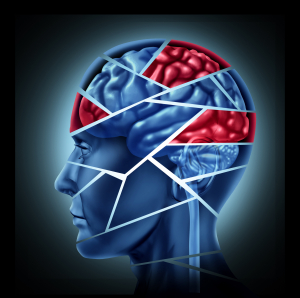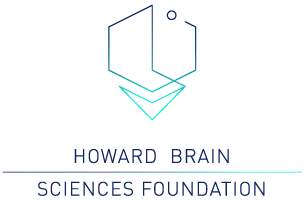This month the HBSF Brain Blog will be devoted to posts about Traumatic Brain Injury (TBI) and related disorders such as Chronic Traumatic Encephalopathy (CTE). Silver, McAllister, Arcinegas and the American Psychiatric Association (2019), define TBI as, “a disruptions of brain function and/or structure due to the application of external physical force that produces sign[s] & symptoms of dysfunction in the acute injury period” in their book Traumatic Brain Injury (Silver et al. 2019).

This definition places emphasis on the injury based aspect of TBI and intentionally leaves the definition “sign[s] and symptoms” open to provider interpretation. Other definitions of TBI include stricter clauses that define the types of disruptions. The World Health Organization along with the CDC define TBI as (Kraus, & Romer, 1995) :
- An occurrence of injury to the head with at least one of the following:
- observed or self-reported alteration of consciousness or amnesia due to head trauma,
- Neurologic[al] or neuropsychological changes or diagnoses of skull fracture or intracranial lesions that can be attributed to the head trauma;
- or an occurence of death resulting from trauma with head injury or traumatic brain injury listed in the sequence of conditions that resulted in death.
The Glasgow Coma Scale is one of the most frequently used means to diagnose TBI (Dewan et al., 2018). The Glasgow Coma Scale is a point based scale that measures a patient’s capability and dependence on others. The lower the patient’s score, the more severe their brain injury is. There are four categories: Mild (13-15 points), Moderate (9-12 points), Severe (3-8 points), and Vegetative State (less than 3 points) (Silver et al., 2019). The points are scored in the categories of motor response, verbal response, and eye opening, the patient’s motor response carrying the most weight as the category is a source of 6 possible points (niftyadmin, 2000).
Despite its name, a mild TBI can still be a difficult prognosis for a patient. Common symptoms include: fatigue, headaches, visual disturbances, amnesia, poor concentration, sleep disturbance, dizziness, irritability, depression, and seizures. These symptoms may appear as soon as a few days after the initial injury and can last over a year. Mild TBI is associated with loss of consciousness (LOC) less than 30 minutes and is known more commonly as a concussion (niftyadmin, 2000). However, minor impact to the brain can cause neural damage with the absence of LOC and further studies need to be conducted (Mayo Clinic Staff, n.d.; Povlishock, Becker, & Cheng, 1983).
Moderate and severe TBI often affect speech, further disrupt sleep and cognition, and lead to weakness in extremities. Additional symptoms, especially related to the site of injury are common. Moderate TBIs are associated with LOC of up to 24 hours and post-traumatic amnesia related to the event with symptoms lasting as long as a week. Severe TBIs are often associated with longer periods of unconsciousness and memory loss (niftyadmin, 2000; Silver et al., 2019).
The more severe TBI is, the more changes also begin to modify what we tend to perceive as a patient’s personality. Changes in behavior, impulse control, and irritability not only affect the patient negatively, but can distance them from potential support systems and caregivers (niftyadmin, 2000 Silver et al., 2019).
In the words of Newton Howard (Chair & Founder), “TBI is the trauma that does not bleed, like time with no directional velocity. Simply a beastly creature, one that moves into the darkest corners of our mind and converts the home of our souls to the valley of death.” TBIs not only damage the brain, but can change a patient’s perception of self and relation to others.
Complications and interactions with other injuries or disorders are common, and patients experiencing such complications report a lower quality of life. Additionally, there is an association between TBIs and an increase in addictive behaviors. TBI patients are also more at risk to develop other psychiatric disorders, as well as have an increased risk of neurodegenerative diseases (our major area of research at HBSF). Most significantly, Tanya Juarez (CEO) describes, “Similar to PTSD and other behavioral health disorders, mTBi is an unseen wound that is still associated with a stigma in seeking treatment,” patients often “fear[ing] the perception of being labeled with a permanent disability.”
Due to this stigma, combined with a lack of biological markers of injury and reliance on behavioral and self-reported symptoms, TBIs tend to be underdiagnosed (Traumatic Brain Injury, 2020). Though we do not know the actual incidence of TBI worldwide, a group of researchers has used WHO data to estimate there were approximately 939 cases per 100,000 people as of April, 2018 (Dewan et al. 2018). This translates to roughly 69 million people. In 2014, the CDC estimated there to be “2.87 million TBI-related emergency department (ED) visits, hospitalizations, and deaths” across the United States (2019).
The most common causes of TBI according to the CDC include: falls, impact with an object, and motor vehicle accidents. TBIs tend to be common in children and the elderly, two groups at high risk of falling. TBI also often intersects with attempted self-injury, sports activity, or military service, complications in the story of TBI that we will discuss later this month (Tbi: Get the Facts, 2019). Lastly, the current rate of diagnosis of TBI is also challenging for providers to analyze, as it is unclear whether recent increases in diagnoses are due to increased literacy and awareness or a higher incidence rate (Traumatic Brain Injury, 2020).
Either way, TBI can be better prevented through institutional change and engineering. Ergonomic helmets for recreational and military uses (Biomimicry Belgium, n.d.), as well as changes in perception of disability are both roads to easy changes in prevalence and prognosis for TBI. If you or someone you know have experienced a TBI and need help, you can contact HBSF’s Patient Advocacy program at patientadvocacy@brainsciences.org or look into care, prognosis, and federal resources available for TBI here.
Written by Senia Hardwick
References
Biomimicry Belgium (n.d.), Helmets Inspired by Woodpecker. Retrieved from https://www.traumaticbraininjury.com/glasgow-coma-scale/
Dewan, M. C., Rattani, A., Gupta, S., Baticulon, R. E., Hung, Y.-C., Punchak, M., Agrawal, A., Adeleye, A. O., Shrime, M. G., Rubiano, A. M., Rosenfeld, J. V., & Park, K. B. (2018). Estimating the global incidence of traumatic brain injury. Journal of Neurosurgery, 1–18. https://doi.org/10.3171/2017.10.JNS17352
J.T. Povlishock, D.P. Becker, C.L.Y. Cheng, G.W. (1983). Vaughan, Axonal Change in Minor Head Injury, Journal of Neuropathology & Experimental Neurology, Volume 42, Issue 3, May 1983, Pages 225–242, Retrieved from https://doi.org/10.1097/00005072-198305000-00002 (Povlishock, Becker, & Cheng, 1983)
Kraus, J. F., & Romer, C. J. (1995). Standard for Surveillance of Neurotrauma (D. J. Thurman, Ed.). World Health Organization. http://whqlibdoc.who.int/hq/1996/WHO_EHA_SPI_96.1.pdf?ua=1
niftyadmin. (n.d.). Glasgow coma scale. Traumatic Brain Injury. Retrieved January 2, 2020, from https://www.traumaticbraininjury.com/glasgow-coma-scale/
niftyadmin. (n.d.-b). Mild TBI Symptoms. Traumatic Brain Injury. Retrieved January 2, 2020, from https://www.traumaticbraininjury.com/mild-tbi-symptoms/
Silver, J. M., McAllister, T. W., Arciniegas, D. B., & American Psychiatric Association (Eds.). (2019). Textbook of traumatic brain injury (Third edition, chapter 1). American Psychiatric Association Publishing. Retrieved from https://books.google.com/books
Tbi: Get the Facts | Concussion | Traumatic Brain Injury | CDC Injury Center. (2019, March 11). https://www.cdc.gov/traumaticbraininjury/get_the_facts.html
Traumatic brain injury – causes, symptoms and treatments. (n.d.). Retrieved January 6, 2020, from https://www.aans.org/
